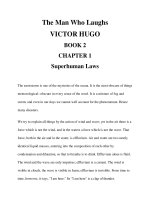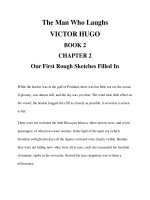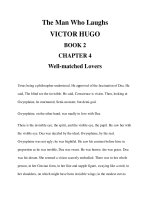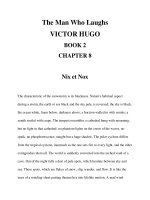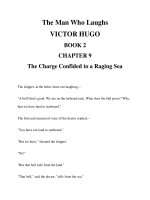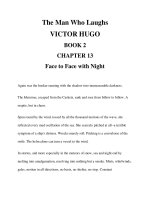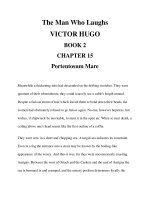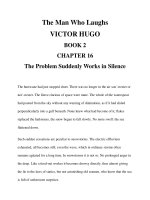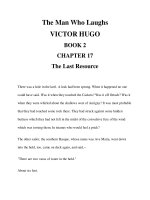The Man Who Laughs VICTOR HUGO PART 1-BOOK 2 CHAPTER 11 pdf
Bạn đang xem bản rút gọn của tài liệu. Xem và tải ngay bản đầy đủ của tài liệu tại đây (25.66 KB, 10 trang )
The Man Who Laughs
VICTOR HUGO
BOOK 2
CHAPTER 11
The Caskets
It was indeed the Caskets light.
A lighthouse of the nineteenth century is a high cylinder of masonry, surmounted
by scientifically constructed machinery for throwing light. The Caskets lighthouse
in particular is a triple white tower, bearing three light-rooms. These three
chambers revolve on clockwork wheels, with such precision that the man on watch
who sees them from sea can invariably take ten steps during their irradiation, and
twenty-five during their eclipse. Everything is based on the focal plan, and on the
rotation of the octagon drum, formed of eight wide simple lenses in range, having
above and below it two series of dioptric rings; an algebraic gear, secured from the
effects of the beating of winds and waves by glass a millimetre thick[6], yet
sometimes broken by the sea-eagles, which dash themselves like great moths
against these gigantic lanterns. The building which encloses and sustains this
mechanism, and in which it is set, is also mathematically constructed. Everything
about it is plain, exact, bare, precise, correct. A lighthouse is a mathematical figure.
In the seventeenth century a lighthouse was a sort of plume of the land on the
seashore. The architecture of a lighthouse tower was magnificent and extravagant.
It was covered with balconies, balusters, lodges, alcoves, weathercocks. Nothing
but masks, statues, foliage, volutes, reliefs, figures large and small, medallions
with inscriptions. Pax in bello, said the Eddystone lighthouse. We may as well
observe, by the way, that this declaration of peace did not always disarm the ocean.
Winstanley repeated it on a lighthouse which he constructed at his own expense,
on a wild spot near Plymouth. The tower being finished, he shut himself up in it to
have it tried by the tempest. The storm came, and carried off the lighthouse and
Winstanley in it. Such excessive adornment gave too great a hold to the hurricane,
as generals too brilliantly equipped in battle draw the enemy's fire. Besides
whimsical designs in stone, they were loaded with whimsical designs in iron,
copper, and wood. The ironwork was in relief, the woodwork stood out. On the
sides of the lighthouse there jutted out, clinging to the walls among the arabesques,
engines of every description, useful and useless, windlasses, tackles, pulleys,
counterpoises, ladders, cranes, grapnels. On the pinnacle around the light
delicately-wrought ironwork held great iron chandeliers, in which were placed
pieces of rope steeped in resin; wicks which burned doggedly, and which no wind
extinguished; and from top to bottom the tower was covered by a complication of
sea-standards, banderoles, banners, flags, pennons, colours which rose from stage
to stage, from story to story, a medley of all hues, all shapes, all heraldic devices,
all signals, all confusion, up to the light chamber, making, in the storm, a gay riot
of tatters about the blaze. That insolent light on the brink of the abyss showed like
a defiance, and inspired shipwrecked men with a spirit of daring. But the Caskets
light was not after this fashion.
It was, at that period, merely an old barbarous lighthouse, such as Henry I. had
built it after the loss of the White Ship a flaming pile of wood under an iron trellis,
a brazier behind a railing, a head of hair flaming in the wind.
The only improvement made in this lighthouse since the twelfth century was a pair
of forge-bellows worked by an indented pendulum and a stone weight, which had
been added to the light chamber in 1610.
The fate of the sea-birds who chanced to fly against these old lighthouses was
more tragic than those of our days. The birds dashed against them, attracted by the
light, and fell into the brazier, where they could be seen struggling like black
spirits in a hell, and at times they would fall back again between the railings upon
the rock, red hot, smoking, lame, blind, like half-burnt flies out of a lamp.
To a full-rigged ship in good trim, answering readily to the pilot's handling, the
Caskets light is useful; it cries, "Look out;" it warns her of the shoal. To a disabled
ship it is simply terrible. The hull, paralyzed and inert, without resistance, without
defence against the impulse of the storm or the mad heaving of the waves, a fish
without fins, a bird without wings, can but go where the wind wills. The lighthouse
shows the end points out the spot where it is doomed to disappear throws light
upon the burial. It is the torch of the sepulchre.
To light up the inexorable chasm, to warn against the inevitable, what more tragic
mockery!
CHAPTER 12
Face to Face with the Rock
The wretched people in distress on board the Matutina understood at once the
mysterious derision which mocked their shipwreck. The appearance of the
lighthouse raised their spirits at first, then overwhelmed them. Nothing could be
done, nothing attempted. What has been said of kings, we may say of the waves
we are their people, we are their prey. All that they rave must be borne. The nor'-
wester was driving the hooker on the Caskets. They were nearing them; no evasion
was possible. They drifted rapidly towards the reef; they felt that they were getting
into shallow waters; the lead, if they could have thrown it to any purpose, would
not have shown more than three or four fathoms. The shipwrecked people heard
the dull sound of the waves being sucked within the submarine caves of the steep
rock. They made out, under the lighthouse, like a dark cutting between two plates
of granite, the narrow passage of the ugly wild-looking little harbour, supposed to
be full of the skeletons of men and carcasses of ships. It looked like the mouth of a
cavern, rather than the entrance of a port. They could hear the crackling of the pile
on high within the iron grating. A ghastly purple illuminated the storm; the
collision of the rain and hail disturbed the mist. The black cloud and the red flame
fought, serpent against serpent; live ashes, reft by the wind, flew from the fire, and
the sudden assaults of the sparks seemed to drive the snowflakes before them. The
breakers, blurred at first in outline, now stood out in bold relief, a medley of rocks
with peaks, crests, and vertebræ. The angles were formed by strongly marked red
lines, and the inclined planes in blood-like streams of light. As they neared it, the
outline of the reefs increased and rose sinister.
One of the women, the Irishwoman, told her beads wildly.
In place of the skipper, who was the pilot, remained the chief, who was the captain.
The Basques all know the mountain and the sea. They are bold on the precipice,
and inventive in catastrophes.
They neared the cliff. They were about to strike. Suddenly they were so close to
the great north rock of the Caskets that it shut out the lighthouse from them. They
saw nothing but the rock and the red light behind it. The huge rock looming in the
mist was like a gigantic black woman with a hood of fire.
That ill-famed rock is called the Biblet. It faces the north side the reef, which on
the south is faced by another ridge, L'Etacq-aux-giulmets. The chief looked at the
Biblet, and shouted,
"A man with a will to take a rope to the rock! Who can swim?"
No answer.
No one on board knew how to swim, not even the sailors an ignorance not
uncommon among seafaring people.
A beam nearly free of its lashings was swinging loose. The chief clasped it with
both hands, crying, "Help me."
They unlashed the beam. They had now at their disposal the very thing they
wanted. From the defensive, they assumed the offensive.
It was a longish beam of heart of oak, sound and strong, useful either as a support
or as an engine of attack a lever for a burden, a ram against a tower.
"Ready!" shouted the chief.
All six, getting foothold on the stump of the mast, threw their weight on the spar
projecting over the side, straight as a lance towards a projection of the cliff.
It was a dangerous manoeuvre. To strike at a mountain is audacity indeed. The six
men might well have been thrown into the water by the shock.
There is variety in struggles with storms. After the hurricane, the shoal; after the
wind, the rock. First the intangible, then the immovable, to be encountered.
Some minutes passed, such minutes as whiten men's hair.
The rock and the vessel were about to come in collision. The rock, like a culprit,
awaited the blow.
A resistless wave rushed in; it ended the respite. It caught the vessel underneath,
raised it, and swayed it for an instant as the sling swings its projectile.
"Steady!" cried the chief; "it is only a rock, and we are men."
The beam was couched, the six men were one with it, its sharp bolts tore their arm-
pits, but they did not feel them.
The wave dashed the hooker against the rock.
Then came the shock.
It came under the shapeless cloud of foam which always hides such catastrophes.
When this cloud fell back into the sea, when the waves rolled back from the rock,
the six men were tossing about the deck, but the Matutina was floating alongside
the rock clear of it. The beam had stood and turned the vessel; the sea was
running so fast that in a few seconds she had left the Caskets behind.
Such things sometimes occur. It was a straight stroke of the bowsprit that saved
Wood of Largo at the mouth of the Tay. In the wild neighbourhood of Cape
Winterton, and under the command of Captain Hamilton, it was the appliance of
such a lever against the dangerous rock, Branodu-um, that saved the Royal Mary
from shipwreck, although she was but a Scotch built frigate. The force of the
waves can be so abruptly discomposed that changes of direction can be easily
managed, or at least are possible even in the most violent collisions. There is a
brute in the tempest. The hurricane is a bull, and can be turned.
The whole secret of avoiding shipwreck is to try and pass from the secant to the
tangent.
Such was the service rendered by the beam to the vessel. It had done the work of
an oar, had taken the place of a rudder. But the manoeuvre once performed could
not be repeated. The beam was overboard; the shock of the collision had wrenched
it out of the men's hands, and it was lost in the waves. To loosen another beam
would have been to dislocate the hull.
The hurricane carried off the Matutina. Presently the Caskets showed as a harmless
encumbrance on the horizon. Nothing looks more out of countenance than a reef of
rocks under such circumstances. There are in nature, in its obscure aspects, in
which the visible blends with the invisible, certain motionless, surly profiles,
which seem to express that a prey has escaped.
Thus glowered the Caskest while the Matutina fled.
The lighthouse paled in distance, faded, and disappeared.
There was something mournful in its extinction. Layers of mist sank down upon
the now uncertain light. Its rays died in the waste of waters; the flame floated,
struggled, sank, and lost its form. It might have been a drowning creature. The
brasier dwindled to the snuff of a candle; then nothing; more but a weak, uncertain
flutter. Around it spread a circle of extravasated glimmer; it was like the quenching
of: light in the pit of night.
The bell which had threatened was dumb. The lighthouse which had threatened had
melted away. And yet it was more awful now that they had ceased to threaten. One
was a voice, the other a torch. There was something human about them.
They were gone, and nought remained but the abyss.
